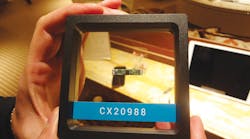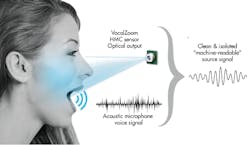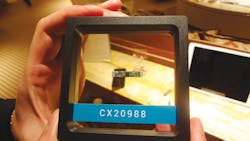This file type includes high resolution graphics and schematics when applicable.
1. VocalZoom uses an infrared range finder to measure skin vibration when speaking to implement a high precision microphone that is essentially unaffected by ambient noise.
If you think there has not been much change in audio technology recently, then you missed the 2017 Consumer Electronics Show where a host of new technologies and products were on display. This is in addition to the plethora of Bluetooth earbuds that use wireless charging in addition to wireless connectivity.
One new technology was hidden in a corridor at Honda’s booth. VocalZoom was showing off its Human Machine Communications (HMC) sensor (Fig. 1). This high-precision microphone uses optics instead of sound vibrations through the air as with conventional audio microphones. The optical system implements an infrared range finder that detects skin vibration of a person speaking. This is most apparent around the throat, but much of the face provides sufficient feedback for the sensor.
The sensor does need to be aimed at the face, but this is easy with many application scenarios from tracking a car driver’s voice to someone using an automated teller machine (ATM). A head mounted approach could also be used. The advantage of this approach is that only the voice-related vibrations are recorded, so noise cancellation is not required. The sensor is not applicable to all voice command input applications, but the ability to essentially eliminate ambient noise from the input is hard to overlook.
Another key change in mobile audio is the use of USB Type-C connections instead of a headphone jack as with the latest Apple iPhone. Many have complained of the lack of a headphone jack, but the approach offers a range of advantages from a thinner device because of the Type-C connector to a digital audio interface. A USB audio device also provides better control and more information about the device to the operating system and applications using the device.
2. Conexants tiny CX20988 is a low-cost, single chip link between a USB Type-C host and headphones/earphones.
Conexant’s tiny CX20988 (Fig. 2) is a low-cost Type-C audio CODEC that does not require a crystal, allowing it to fit into a very small package. It is available in a 3.09-mm2 WLCSP package. It delivers 24-bit stereo feedback with a 48 kHz sample rate and a five-band equalizer. It has a 1.5mA suspend current to minimize power requirements. It supports four-conductor headset jacks with auto-headset detection. It has multiple LED and button interfaces.
The slightly larger (5 mm2) CX20888 CODEC adds noise cancellation with features like a wake-on-voice trigger. It uses a 100 MHz, dual core, 32-bit DSP that utilizes a pair of PDM digital microphone interfaces (DMICs).
Conexant also demonstrated an impressive smartphone application that works with the chip. It had the ability to disable noise cancellation and feed ambient sound into the headset so I could hear a person speaking to me without having to take off the earphones. It also provides significant listening and noise cancellations adjustment profiles.
This file type includes high resolution graphics and schematics when applicable.




